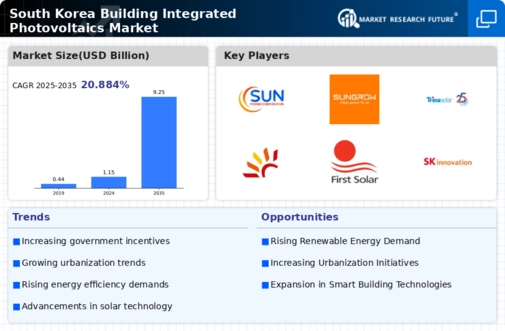Rising Energy Costs
The increasing costs of conventional energy sources in South Korea are driving interest in the building integrated-photovoltaics market. As energy prices rise, consumers and businesses are seeking alternative solutions to mitigate expenses. The integration of photovoltaic systems into building designs offers a dual benefit: reducing energy bills and enhancing property value. In 2025, energy prices have surged by approximately 15%, prompting a shift towards renewable energy solutions. This trend indicates a growing market for building integrated-photovoltaics, as stakeholders recognize the long-term financial advantages of solar energy. Furthermore, the potential for energy independence is appealing, particularly in urban areas where energy demand is high. As a result, the building integrated-photovoltaics market is likely to experience robust growth, driven by the need for cost-effective energy solutions.
Sustainability Initiatives
South Korea's commitment to sustainability and environmental protection is significantly influencing the building integrated-photovoltaics market. The government has set ambitious targets to reduce greenhouse gas emissions by 40% by 2030, which has led to increased investments in renewable energy technologies. Building integrated-photovoltaics align with these sustainability goals, as they contribute to cleaner energy production and reduced carbon footprints. In 2025, the market is projected to grow by 20% as more developers and architects incorporate solar technologies into their designs. This shift not only meets regulatory requirements but also appeals to environmentally conscious consumers. The building integrated-photovoltaics market is thus positioned to thrive as stakeholders prioritize sustainable practices in construction and urban development.
Urbanization and Space Constraints
The rapid urbanization in South Korea is creating challenges related to space and energy consumption, which is propelling the building integrated-photovoltaics market. As cities expand, the demand for energy-efficient buildings increases, particularly in densely populated areas. Building integrated-photovoltaics offer a practical solution by utilizing building surfaces for energy generation without requiring additional land. In 2025, urban areas are expected to account for over 80% of the population, intensifying the need for innovative energy solutions. This trend suggests that integrating photovoltaic systems into building designs will become a standard practice, thereby enhancing the market's growth potential. The building integrated-photovoltaics market is likely to benefit from this urban-centric approach, as it addresses both energy needs and space limitations.
Government Regulations and Standards
The regulatory landscape in South Korea is evolving to support the growth of the building integrated-photovoltaics market. New building codes and standards are being implemented to encourage the adoption of renewable energy technologies in construction. In 2025, regulations mandate that new buildings incorporate a minimum of 10% of their energy needs from renewable sources, which includes solar energy. This regulatory push is likely to stimulate demand for building integrated-photovoltaics, as developers seek to comply with these standards. Additionally, the government is providing financial incentives for projects that meet or exceed these requirements, further enhancing the market's attractiveness. The building integrated-photovoltaics market is thus expected to expand as compliance with regulations becomes a key driver for construction practices.
Technological Advancements in Solar Materials
Advancements in solar technology are playing a crucial role in shaping the building integrated-photovoltaics market. Innovations in materials, such as thin-film solar cells and building-integrated photovoltaics (BIPV), are enhancing the efficiency and aesthetic appeal of solar installations. In 2025, the efficiency of solar panels has improved by approximately 25%, making them more attractive for integration into building designs. These technological improvements not only increase energy output but also reduce installation costs, making solar solutions more accessible to a broader audience. As a result, the building integrated-photovoltaics market is poised for growth, driven by the demand for high-performance solar technologies that seamlessly blend with architectural designs. This trend indicates a shift towards more sophisticated and visually appealing solar solutions.



















Leave a Comment